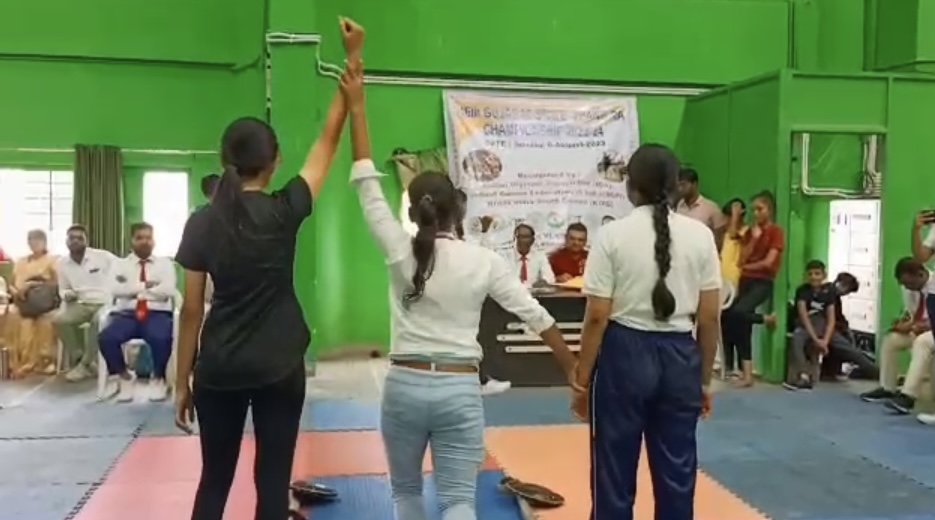My journey into the world of martial arts began with a casual interest in self-defense and a desire to stay physically active. One day, after watching an inspiring martial arts performance, I decided to take the plunge and enroll in martial arts lessons. With dedication and passion, I committed to training for one hour each day, six days a week, for a span of six months. During this time, I not only honed my skills but also delved into various forms of martial arts and self-defense techniques, each offering its unique set of principles and movements. It was during this transformative period that I was introduced to Thang Ta, a mesmerizing form of martial art with its roots in Manipur, India. Intrigued by its blend of traditional weaponry and fluid movements, I decided to take on a new challenge. With a state-level Thang Ta competition on the horizon, I threw myself into rigorous training for a month, pushing my limits. All the hard work paid off when I not only participated but emerged victorious, clinching the gold medal in my age and weight category. This triumphant experience not only reinforced my love for martial arts but also ignited a newfound passion for Thang Ta, further fueling my martial arts journey.
Thang Ta, a mesmerizing and ancient form of martial arts, traces its roots to the northeastern region of India, specifically in Manipur. This captivating martial art form, often referred to as Huyen Lallong or Sarit Sarak, has a rich history and cultural significance that spans centuries. Thang Ta is a unique amalgamation of combat techniques, traditional weaponry, and rhythmic movements, making it a distinctive and captivating martial art practice. Its origins can be traced back to Manipur’s rich heritage, where it has evolved as an integral part of the state’s cultural and historical identity. This art form’s combination of fluid movements and combat proficiency not only makes it an impressive form of self-defense but also a mesmerizing spectacle to witness.
These are the Los catered throughout this activity :
LO 1: Identify own strengths and develop areas for growth
Through my commitment to training for one hour each day, six days a week, over a six-month period, I demonstrated a keen ability to identify my own strengths and proactively develop areas for growth. This dedication allowed me to not only hone my existing martial arts skills but also explore and embrace various forms of martial arts and self-defense techniques, which enhanced my versatility and knowledge. Moreover, my introduction to Thang Ta during this transformative period showcased my openness to new challenges and my willingness to step out of my comfort zone. As I prepared rigorously for the impending state-level Thang Ta competition, I recognized my resilience and determination to push my limits further. Ultimately, winning the gold medal in my age and weight category was a testament to my continuous self-assessment, adaptation, and growth—a journey that exemplified my ability to identify strengths and cultivate them while embracing fresh opportunities for development.
LO 2: Demonstrate that challenges have been undertaken, developing new skills in the process
During my one-month intensive training for a Thang Ta competition, I encountered a multitude of challenges that tested my physical and mental fortitude. From enhancing my strength and stamina to mastering intricate hand movements and tactics, I had to push myself beyond my limits. Time management became crucial as I balanced my regular commitments with the demanding training schedule. However, my commitment to excelling in Thang Ta fueled my determination. Each day, I confronted these challenges head-on, channeling my passion for the art form to overcome obstacles. This journey not only honed my martial arts skills but also highlighted the transformative power of perseverance and unwavering commitment in the face of adversity. Thang Ta served as a testament to the personal growth that arises from embracing challenges with resilience and dedication.
LO 3: Demonstrate how to initiate and plan a CAS experience
My journey began with the initiation of a one-month training program geared towards a state-level Thang Ta competition. This endeavor necessitated careful planning, including setting clear objectives, scheduling daily training sessions, and acquiring the necessary resources and guidance. Challenges were inevitable; the intense physical demands of Thang Ta pushed my endurance and patience to the limit. The mental discipline required for mastering intricate techniques was equally demanding. Nevertheless, the desire to succeed and the support of my trainer and peers kept me motivated.The culmination of this CAS experience was the state-level competition, where I faced formidable opponents.This CAS experience not only showcased my ability to plan and execute a challenging endeavor but also underlined the profound personal growth that can be achieved through commitment and perseverance.
LO4: Show perseverance and commitment in the CAS Experience
Engaging in the martial art of Thang Ta was a remarkable journey filled with challenges that tested my mettle and spurred personal growth. In preparation for a state-level competition, I embarked on an intensive one-month training regimen, where Thang Ta’s intricate techniques became my daily practice. The training demanded unwavering discipline and physical stamina as I navigated through its graceful yet demanding movements with traditional weaponry. Overcoming fatigue and pushing through self-doubt were constant challenges during this period. However, these trials served as opportunities for personal development. I harnessed the determination and focus cultivated through this intense training, and when the day of the state-level competition arrived, I was ready. The culmination of my efforts resulted in a triumphant moment as I clinched the gold medal, an achievement that not only symbolized victory but also highlighted my ability to undertake challenges and develop new skills along the way.
LO 7: Recognize and consider the ethics of choices and actions
As I honed my skills, I also recognized the ethical dimension of martial arts. The principles of respect, fairness, and sportsmanship were embedded in every aspect of my training. It was crucial to uphold these values, not just in victory but also in defeat. When the day of the competition arrived, I competed with both skill and integrity. Ultimately, the hard work and ethical commitment paid off.This experience served as a reminder that in martial arts, as in life, recognizing and embracing ethical choices and actions is just as important as achieving success.

